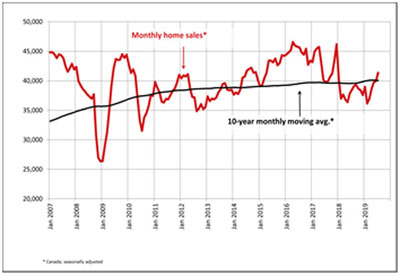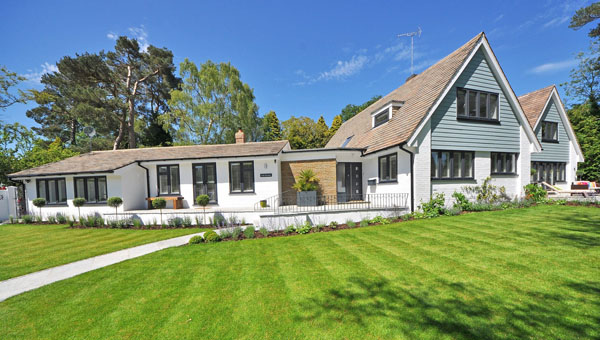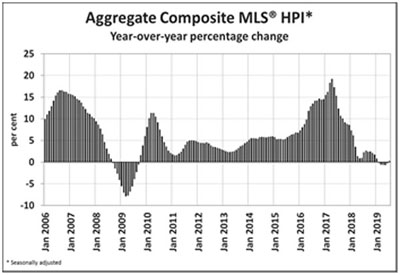OTTAWA, Ontario, August 28, 2019 — Statistics, released recently by the Canadian Real Estate Association (CREA) show national home sales were up in July 2019, compared to June.
Home sales, recorded via Canadian MLS® Systems, rose for the fifth consecutive month in July, putting them about 15 percent above the six-year low, reached in February 2019, but still more than 10 percent below the highs, reached in 2016 and 2017.
Activity advanced in about 60 percent of all local markets. While the monthly increase was led by Greater Vancouver (GVA) and Greater Toronto (GTA), sales in the two areas remain well below levels, recorded prior to the mortgage stress test that came into effect in 2018.

Actual (not seasonally adjusted) sales activity stood 12.6 percent above July 2018. Sales were up from year-ago levels in most of Canada’s largest markets, including the lower mainland of British Columbia, Calgary, Edmonton, the GTA, Hamilton-Burlington, Ottawa and Montreal.
“The extent, to which recent declines in mortgage interest rates have helped lift sales activity, varies by community and price segment,” said Jason Stephen, CREA’s President. “All real estate is local. Nobody knows that better than a professional real estate agent, your best source for information and guidance when negotiating the sale or purchase of a home.”
“Sales are starting to rebound in places where they dropped when the mortgage stress test took effect at the beginning of 2018, but activity remains well below levels recorded prior to its introduction,” said Gregory Klump, CREA’s Chief Economist.
“By the same token, sales continue to rise in housing markets where the mortgage stress test had little impact due to upbeat local economic conditions and a supply of affordably priced homes. Meanwhile, the mortgage stress test is doing no favours for homebuyers and sellers alike in places facing challenging local economic prospects and subdued consumer sentiment,” he added.
The number of newly-listed homes edged back by 0.4 percent in July. There was an almost even split between the number of local markets, where new listings rose, and those where they eased. The increase in new listings in Calgary, the GTA and Edmonton offset a decline in new listings in the lower mainland of British Columbia and Montreal.
The monthly sales increase, together with a marginal monthly decline in new listings, resulted in the national sales-to-new listings ratio tightening to 59.8 percent in July, from 57.6 percent recorded in June. This marks its tightest reading and the biggest deviation above its long-term average (of 53.6 percent) in the past year.
Considering the degree and duration to which market balance readings are above or below their long-term averages is the best way of gauging whether local housing market conditions favour buyers or sellers. Market balance measures that are within one standard deviation of their long-term average are generally consistent with balanced market conditions.
Based on a comparison of the sales-to-new listings ratio with the long-term average, about three-quarters of all local markets were in balanced market territory in July 2019. Of the remainder, all but a few Prairie markets were above the long-term average.
The number of months of inventory is another important measure of the balance between sales and the supply of listings. It represents how long it would take to liquidate current inventories at the current rate of sales activity.
There were 4.7 months of inventory on a national basis at the end of July 2019 – the lowest level since December 2017. While remaining close to its long-term average of 5.3 months, this measure of market balance has increasingly been retreating below it.
While national measures of market balance are still generally in the ballpark of their long-term averages and indicate supply and demand are fairly well balanced, there are significant regional variations.
The number of months of inventory has swollen far beyond long-term averages in Prairie provinces and Newfoundland & Labrador, giving homebuyers ample choice in these regions. By contrast, the measure remains well below long-term averages in Ontario and Maritime provinces, resulting in increased competition among buyers for listings and fertile ground for price gains.
The Aggregate Composite MLS® Home Price Index (MLS® HPI) rose 0.6 percent month-over-month in July 2019, the largest increase in over 2 years.
Seasonally adjusted MLS® HPI readings in July were up from the previous month in 11 of the 18 markets tracked by the index. July’s trends were generally in line with June’s, with virtually all of the gains recorded in housing markets east of the Prairie region.
Prices were flat on a m-o-m basis across the Prairies, with the only material declines posted in the GVA (-0.6 percent) and Fraser Valley (-0.4 percent), where declines were smaller than those posted in June.
By contrast, monthly gains were posted in Barrie (+1.9 percent), Oakville (+1.8 percent), Greater Moncton (+1 percent), the GTA (+0.9 percent), Guelph (+0.8 percent), Ottawa (+0.8 percent), Greater Montreal (+0.7 percent), Hamilton (+0.3 percent) and the Niagara Region (+0.3 percent).
The actual (not seasonally adjusted) Aggregate Composite MLS® HPI edged up by 0.2 percent year-over-year in July 2019 – the first increase since January.
Two-storey single-family home prices edged up 0.3 percent y-o-y in July, while prices for one-storey single family homes and condo apartment units held steady. By contrast, townhouse/row prices retreated by 0.7 percent y-o-y.
A comparison of home prices to year-ago levels yields considerable variations across the country, with the main theme being declines in western Canada and price gains in central and eastern Canada.
Results remain mixed in British Columbia, with prices down on a y-o-y basis in Greater Vancouver (-9.4 percent), the Fraser Valley (-6.7 percent) and the Okanagan Valley (-0.9 percent). Meanwhile, prices were up 1.2 percent in Victoria and climbed 3.4 percent elsewhere on Vancouver Island.
Among Greater Golden Horseshoe housing markets, tracked by the index, MLS® HPI benchmark home prices were up from year-ago levels in Guelph (+6.9 percent), the Niagara Region (+5.9 percent), Hamilton-Burlington (+5 percent), Oakville-Milton (+5 percent) and the GTA (+4.4 percent). By contrast, home prices in Barrie held below year-ago levels (-1.3 percent).
Across the Prairies, supply remains historically elevated relative to sales and home prices remain below year-ago levels. Benchmark prices were down by 3.5 percent in Calgary, 3.2 percent in Edmonton, 4.4 percent in Regina and 1.3 percent in Saskatoon. The home pricing environment will likely remain weak in these cities until demand and supply return to better balance.
Home prices rose 8.9 percent y-o-y in Ottawa (led by a 13.7 percent increase in townhouse/row unit prices), 7.3 percent in Greater Montreal (led by an 8.5 percent increase in apartment unit prices), and 2.4 percent in Greater Moncton (led by a 28.4 percent jump in apartment unit prices).
The MLS® HPI provides the best way to gauge price trends, because averages are strongly distorted by changes in the mix of sales activity from one month to the next.
The actual (not seasonally adjusted) national average price for homes sold in July 2019 was just under $499,000, up 3.9 percent from the same month last year.
The national average price is heavily skewed by sales in the GVA and GTA, two of Canada’s most active and expensive housing markets. Excluding these two markets from calculations cuts more than $105,000 from the national average price, trimming it to less than $393,000.
 Pride News Canada's Leader In African Canadian & Caribbean News, Views & Lifestyle
Pride News Canada's Leader In African Canadian & Caribbean News, Views & Lifestyle






